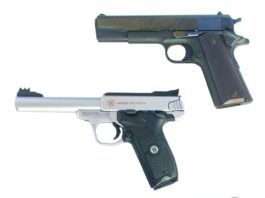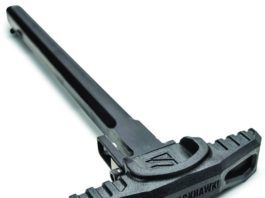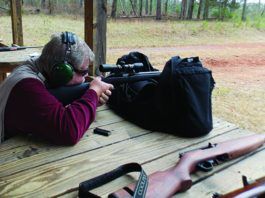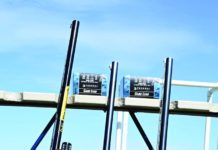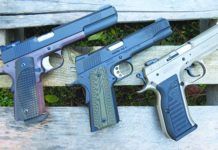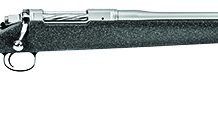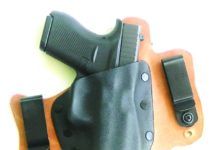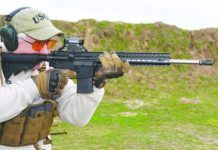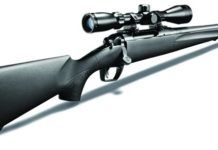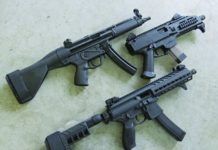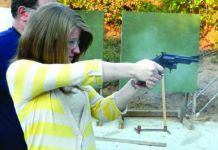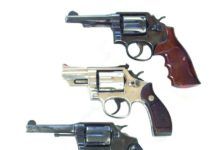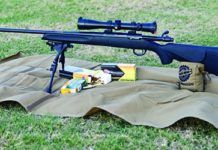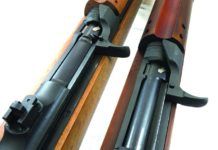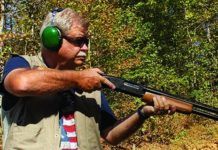Brownings Sweet Sixteen: Still Sweet After All These Years?
The popularity of the 16-gauge shotgun, in particular the Browning A5 Sweet Sixteen, has never waned among those select shooters with a streak of nostalgia in their genetic makeup. A common refrain of, "I've still got my granddad's old 16 — best bird gun ever made," is often heard whenever veteran shooters gather to share tales of old or create new memories of quality time in the outdoors.
Responding to a reader's request, we decided to give the recently unveiled Browning A5 Sweet Sixteen that premiered at the 2016 SHOT Show a closer look to see what motivates the 16 gauge's small, but very loyal, fan base. The new semiautomatic is built with a smaller, lighter receiver than the old-style Humpback and utilizes a different recoil system than the long-recoil creation of legendary firearms genius John M. Browning, so only time will tell if it has the lasting power of its predecessors.
The Light Twelve was added to the mix for a couple of reasons. First, the older Sweet Sixteen is built on the same-sized frame as the 12 gauge. Also, we wanted to see if the 16 gauge lives up to its reputation as a more sporting shooting tool. And, of course, 12-gauge ammunition is much more available than 16-gauge shotshells, and if the potential wingshooter is in the market for one of these Humpbacks, how much will nostalgia and pride of ownership of a "Sweet Sixteen" override the economics of shooting the bigger gauge, assuming similar performance?
Three More 10mm Autos: Kimber, Dan Wesson, Tanfoglio
Last year we tested three 10mm Auto pistols and found there was a lot of interest in these big-bore handguns, so we decided to return to these powerful handguns for another look. Our most recent crop of 10mms includes two 1911 platforms and one based on the CZ 75 platform. The Kimber Custom TLE II and the Dan Wesson Bruin Bronze share the 1911 platform, while the Tanfoglio Witness is based on the CZ 75 design. We liked all three of these pistols and found that all three could serve multiple duties from hunting to self-defense. Since the 10mm has the power of a 41 Magnum, we feel it is a bit much for everyday carry. If we ever were in a shooting incident, it's possible the overpenetration of the 10mm could be a liability. But in a self-defense situation where you are facing an angry bear in the back country, we think the 10mm Auto makes perfect sense. Also, as a hunting round, the 10mm offers a lot of power and is well suited for game like deer and pigs at short distances. We'd even use it in a tree stand to take black bears visiting a bait.
All three pistols ran exceptionally well with no malfunctions or jams, and we found they were accurate. Two-inch five-shot groups at 25 yards were the norm. For ammunition, we used SIG Sauer V-Crown Ammunition loaded with an 180-grain JHP bullet. The SIG ammo was loaded to velocities that 10mm Auto was designed for.
The other two loads were Federal American Eagle and Armscor USA labels, both using 180-grain FMJs. These two rounds weren't as hot as the SIG load, as the table data reveal. The SIG ammo factory data shows a muzzle velocity of 1250 fps; we got very close to that muzzle velocity from the Kimber and Dan Wesson. The Tanfoglio produced less velocity. The Federal and Armscor ammo is factory-speed stamped at 1030 fps and 1008 fps, respectively. With the three pistols, we saw higher muzzle velocities than the factory figures.
For accuracy testing, we used a rest and open sights, firing at targets placed 25 yards downrange. For our speed stage, we fired at 10 yards. A fast and accurate follow-up shot was faster with the Bruin and Witness, which we will get into shortly. Remember that a 10mm Auto is not a learner's pistol or for those who are sensitive to recoil. In our opinion, the Bruins and the Witness helped us manage recoil the best. Shooting this trio side by side at the range, we learned a lot about them. Here's the skinny on all three.
New Rifles at SHOT 2017
At the 2017 Shooting, Hunting, Outdoor Trade (SHOT) Show in Las Vegas in January, Gun Tests staffers saw that although new modern sporting rifles do not dominate the introductions of rifles this year, another major manufacturer has entered that AR-15 market with a product that's selling well. So now's the time to buy your AR because prices should be falling.
Of course, you should find plenty new to like elsewhere in the 2017 rifle world, with new rimfire offerings, new youth offerings, and plenty of threaded muzzles for those suppressors that may be deregulated soon.
Holsters for the Glock 42: We Test Ten for Everyday Carriers
The Glock 42 380 ACP is becoming a very successful handgun since its introduction three years ago, which has lead to many makers large and small rolling out holster rigs for this handgun. The Glock 42 is exceptionally well balanced but light, so it may require a little extra effort to be certain the Glock 42 is sheathed with a balance of speed and retention. Short and light guns sometimes roll out and require extra effort to holster securely. Fortunately, a number of makers offer good designs for this handgun, as we recently found out.
The Glock 42 is every bit a concealed carry handgun, and we think it is too important to go cheap on a holster for this activity, and you probably need more than one holster to cover all the different ways you or your spouse might carry it. Some of the holsters we tested below represent a good deal for the price and seem to do as well as others with more features. Here's what we thought about ten holsters that may suit your Glock 42 needs.
AR-15 Carbines for Less Than $1300: The Winner is a Saint
A staff member recently paid $2300 for a complete AR-15 carbine without regret. But you may have noticed complete uppers selling for as little as $400 during the last rounds of holiday sales and complete carbines selling for less than $700. Why pay more? One answer would be to take advantage of the latest technology in terms of manufacturing, helpful features and improved ammunition. Forged rather than cast aluminum is now the standard, and machining is more exact thanks to computer numerically controlled (CNC) automation. The efficiency and versatility of barrels have been upgraded to take advantage of heavier bullets able to land a more effective blow at greater distance. Barrels with twist rates of 1:8 inches and even 1:7 inches have replaced the original-issue lands and grooves that spun the bullets at a rate of 1:9. Handguards are now modular platforms for lights, lasers, and sights, and ambidextrous fire controls are becoming more popular as well.
With the desire for a more up-to-date AR-15, we went shopping and found that we didn't have to break the bank — just get comfortable within a price range of about $900 to $1250 dollars. What we came up with was three AR-15s with upgrades that distinguished them from more traditional models.
308 Winchester Bolt-Actions: Remingtons M783 Rifle Wins
Among the most useful, versatile, and powerful all-round sporting rifles is the 308 Winchester bolt action. These rifles are accurate, reliable, and can take on small to big game in many hunting conditions. When married with a good optic and in competent hands, they are well suited to take a 200-pound target at 200 yards and beyond, as a rule of thumb. The chambering is a joy to use and fire, compared to hard-kicking magnums, and offers plenty of recreational value. The bolt-action 308 is also a useful tactical rifle in many situations, and the round is widely used by law enforcement across the country.
We recently took a hard look at four bolt-action rifles chambered in 308 Winchester, with a special emphasis on looking for affordable options. So we chose two used rifles and one lower-cost new rifle and compared them to a rifle in a higher price range to ensure we weren't missing something that more dollars could provide. These rifles included the now-discontinued Mossberg ATR, the Remington 783, the Remington 700 SPS, and the Savage Axis. In this quartet, we shot three loads for accuracy testing and another load in offhand fire to gauge the accuracy of the rifles. As it turns out, the economy combination rifle that comes from the factory with a bore-sighted scope is a good deal. Though the Remington 783 was the most accurate rifle, we also liked the Remington 700 SPS a lot. Overall, however, the Savage Axis combination seems a best buy. Let's look hard at these rifles and delve into why we made these choices and to see if you agree with our assessments.
Forward-Mounted-Mag 9mm Pistols from SIG, Zenith, & CZ
In the October 2016 issue, we tested three high-capacity 9mm Luger pistols and found them somewhat lacking in defensive scenarios, though we did enjoy shooting one, the MPA Defender, which was sized more like a regular pistol than the carbine-like SIG MPX and which functioned better than an Uzi Mini Pro. But there are an increasing number of pistols that, save for a couple of features, function more like Short-Barreled Rifles (SBRs), which are controlled by much more stringent regulations under the National Firearms Act and are vastly more expensive and hard to get. The SIG MPX-PSB, for example, is similar to the unit we tested last October except it comes with a Stabilizing Brace, thus the "SB" in the name, compared to the "P" designation we initially tested.
This round, we found products more alike in size to the SIG Sauer MPX-PSB, namely, the CZ Scorpion EVO 3 S1 and the Zenith Firearms MKE Z-5RS with SB Brace. The Zenith and SIG came with a stabilizing brace, while the CZ did not, but it could be purchased separately. The SIG, CZ, and Zenith are tactical looking firearms because they all have a military ancestry that is especially noticeable due to the magazine mounted in front of the trigger guard and not in the grip. The three pistols tested are all semi-automatic, require two hands to shoot with any degree of accuracy, use high-round-capacity magazines compared to typical full-size handguns, and have the ability to be fired with a stabilizing brace. These pistols also represent three different operating mechanisms: the SIG uses a short push-rod gas system; the CZ a simple blowback system, and the Zenith a delayed roller-block mechanism. During firing, we noticed big differences in the mechanisms in both manual operation and cycling when fired, which we will get into. The ergonomics and controls differed as well, yet we found our ramp-up time transitioning between handguns to be short.
Initially, there is an awkwardness shooting these pistols because they feel like an SBR yet have no stock for a steady aim, and they are too heavy to fire in a Weaver, Isosceles, or hybrid stance with a two-hand hold like a typical handgun. We believe adequate range time and proper training is needed to master these pistols.
Most important, we wondered if, out of the box, these similar, yet different, pistols would work as home-defense choices. In our opinion, the upside of these three pistols is that they offer high magazine capacities, decent accuracy, and a lot of shooting fun. Yes, these pistols can make empty brass very quickly. On the downside is cost. Yes, you can purchase a lot less gun for a lot less money and achieve the same self-defense goal as what this trio delivers, we believe. Still, we looked forward to seeing what each firearm could do at the range.
357 Magnum Personal Defense Loads: Black Hills Is a Best Buy
When it comes to the 357 Magnum cartridge, the consensus is the round is a great performer. The cartridge has taken deer, bears, and even larger game. However, the rub is that these exploits were made with larger revolvers, often with barrels of at least 6 inches. When it comes to personal defense, most folks are going to carry a 2-, 3-, or 4-inch-barrel revolver. So, for those shooters who prefer the wheelgun, the Magnum needs to work in a shorter barrel.
The slow-burning powder used in Magnum loads is often a canister grade of Winchester 296 or Hodgdon H 110. This powder develops its power and velocity from a slower burn. Purpose-designed defense loads must use relatively faster-burning powder, usually a powder in the middle range. Another problem with accuracy and consistent performance is bullet pull. The lighter bullets used in defense loads often do not show as consistent a powder burn as heavier bullets, and this limits velocity with 100- to 110-grain bullets. However, makers such as Cor-Bon seem to have perfected a loading process that has solved many of the problems with bullet pull and have even gotten a consistent powder burn in short barrels. More pertinent in recent years, the Magnum has been downloaded. In present form, SAAMI specs restrict 357 Magnum pressure levels to about the same as 9mm +P+ loads.
When you consider the flash, blast, and recoil inherent in the Magnum cartridge, the question must be asked: Is the 357 Magnum the best choice for personal defense over other revolver cartridges? We believe it is. The Magnum offers excellent performance in a relatively compact package that the big-bore revolvers cannot match for speed and packing ability. The Magnum is superior to the 38 Special, no matter how hot the Special is loaded. In the May 2012 issue, we looked at the 357 Magnum for animal defense and also have looked at the 9mm versus the 357 Magnum. In this report, we are looking at the 357 Magnum solely as a personal-defense cartridge and letting the Magnum stand on its own.
There are several concerns in choosing the 357 Magnum for personal defense. One of our raters has a great deal of police experience. He noted that the 22 LR, as an example, was a proven, though under-regarded, self-defense round when fired from a rifle largely because of the ease with which accuracy was obtained. From a pistol, the results are often dismal, so the shorter-barrel, lighter revolvers might also produce poor results. Another concern is muzzle blast. The concussion inside a home could be severe, the muzzle blast is tremendous in dim light, and sometimes the flash causes night blindness. The Magnum might literally leave you deaf and dumb. However, some modern loads are especially treated to create only light muzzle flash, and as a result, they are much better suited to personal defense. If you choose a heavy hunting load and fire it in a 4-inch barrel, you will probably experience excess muzzle blast. If you use the 110-grain Cor-Bon personal-defense load, you will not experience this excess muzzle blast. The Buffalo Bore 125-grain Tactical load is another excellent choice, carefully tailored to personal defense.
Used 38 Sp. Revolver Contest: Colt, Smith & Wesson, Ruger
Revolvers make excellent home-defense handguns. They are simple to use and reliable and will come up shooting after long periods of storage. There are no springs compressed when the revolver is loaded, and no magazines to keep up with. The revolver may be chambered for powerful and efficient cartridges, such as the 38 Special +P and the 357 Magnum. For shooters able to engage in only minimal training, the revolver makes a lot of sense. Conversely, many very experienced shooters trust the revolver and little else. The smooth-rolling double-action trigger helps avoid flinch and the rhythm, once learned, allows excellent hit probability.
We set out to find four used revolvers for this Bargain Hunter segment. They had to be high quality and chambered for either the 38 Special or 357 Magnum cartridge, with the emphasis on 38 Special. While most homeowners will load these revolvers with 38 Special ammunition, the 357 Magnum is certainly a viable option, so we tested the revolvers chambered for the Magnum cartridge with these heavy loads as well. Because we were looking for bargains, we limited the used cost to a maximum of $500 counter price. We found one revolver at that maximum and three for considerably less, including two revolvers at $300. We chose medium-frame revolvers for two of the handguns and small frames for the other two handguns.
Three were six-shot revolvers and one was a five-shooter. We elected not to pursue heavy-frame revolvers, such as the Smith & Wesson L frame or Ruger GP100, and we also did not look for J-frame type snubnose revolvers. Basically, we were looking for affordable houseguns that would do a credible job of home defense if called upon. The contenders were as follows
Mid-Caliber Bolt-Action Rifles From T-C, Browning, and CZ USA
Recently, we assembled a panel and arrived at what could be described as a list of practical considerations for choosing an all-around rifle. Not a specialty piece, mind you, but a "daily driver," so to speak. Our test team came up with three considerations we wanted: power, accuracy, and portability. We agreed that in terms of power, we'd like to be able to hunt at least some deer-sized animals, but not with so much power that the rifle was too heavy to carry or generate so much recoil that it was unpleasant to shoot. To us, this meant short-action calibers greater than 223 Remington but less than 308 Winchester. In terms of accuracy, it wasn't long ago that producing a 1-inch group at 100 yards (1 minute of angle) was a high standard. Certainly 1 MOA is still a benchmark, but recent state-of-the-art machinery has made it possible to buy such guns over the counter. And last, but certainly not least, there's portability. Today, that is just as likely to mean aboard an ATV as it is over the shoulder. Either way, slender and compact is still the desired profile. Thus, the focus of this test became four bolt-fed short-action rifles in medium or midrange cartridges. The lineup was as follows:
We had intended to keep the maximum length of our rifles to less than 40 inches, but we decided to include the 41.5-inch-long Thompson Center Compass because we were eager to find out if this $399 rifle chambered for 22-250 Remington had recovered since its sudden recall for safety issues. Adding to its appeal was its threaded barrel, ready for a suppressor or muzzle brake.
Our shortest rifle was also chambered for 22-250. The $859 Browning X-Bolt Micro Midas offered a Grade 1 satin-finish walnut stock with 12.5-inch length of pull and about one additional inch of stock spacers. The Micro also weighed the least, as little as 6.1 pounds unloaded.
In the middle we chose the newest model 557 from CZ USA. The Sporter Short Action chambered for 243 Winchester was perhaps the most traditional rifle, with a checkered walnut stock.
The least traditional rifle, at least in terms of appearance, was the Howa Mini Action rifle from Legacy Sports International. Its multi-cam finish, 6.5 Grendel chambering, and 10-round detachable box magazine set it apart from the others. The right size overall, we hoped the big magazine sticking out the bottom would not make the Howa too difficult to pack.
Reproduction M1 Carbines: We Test Auto-Ordnance and Inland Manufacturing Models
The M1 Carbine was adopted during World War II, then proceeded to arm our soldiers during the Korean War and Vietnam War, making it one of the most widely produced of all U.S. Military rifles. Millions were produced, and at one time, surplus models were quite common and inexpensive. Try finding a vintage M1 Carbine today, and you will pay close to $1000 for a well-used specimen. Costs, however, will vary dramatically depending on which manufacturer produced the M1 Carbine, the model, features, and condition.
We opted to test two new M1 Carbine reproductions, the M1 1945 Carbine from Inland Mfg. (not the original Inland Mfg. but a new company) and the M1 Carbine Paratrooper from Auto-Ordnance (A-O).
We looked at these two Carbines for historical accuracy, for competition use in M1 Carbine Matches, and as a home-defense choice. In our opinion, the Inland is suitable for all three, where the A-O is not competition ready, but it satisfies the other two roles pretty well. Bottom line, our test team found these two carbines to be reliable, depending on the ammunition employed, offer good performance if the cartridge is used within its limits, and unlike some other M1 Carbines our testers have fired in the past, these two reproductions are accurate enough for nearly any use.
Budget 20-Gauge Shoot Off: H&R, Century, and Mossberg
The shotgun can be an important part of the home-defense firearms collection. The scattergun offers excellent hit probability and provides a formidable option for those concerned with home invasions. The wisdom of such preparedness is reflected in the headlines every day. We live in a dangerous world. The problem is, many of us are on a budget and cannot afford a thousand-dollar tactical shotgun. Others are recoil shy or have a physical impairment that makes firing the mighty 12 gauge difficult. Even some who may be able to handle the 12 well will find the light and fast-handling 20 gauge has appeal.
In this installment, we test three affordable 20-gauge shotguns. The 20 gauge was chosen because, while generating about half the recoil of the 12 gauge, it has a little more than half the payload, which considering the ample power of the shotgun, seems to be a reasonable trade off. Even better for the tests, as it turns out the shotguns were choked Open, Modified and Full, giving us a unique opportunity to compare chokes and how they affect shot spread at home-defense ranges. After weeks of searching, we found three shotguns at or under $300. These included the Century International Arms JW-2000 double-barrel coach gun, a Mossberg 20-gauge pump, and an H&R Pardner single shot. Some may scoff at the idea of even considering the single shot or double barrel for home defense, but we found that while they might not be ribeye, they aren't chopped liver if used properly.



























